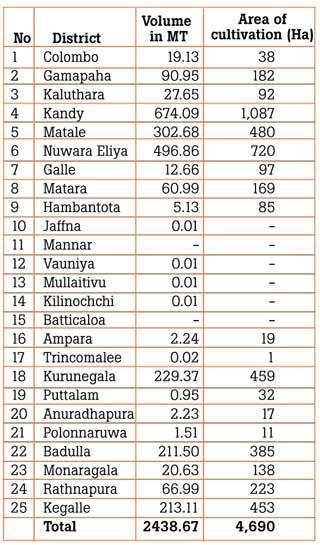Reply To:
Name - Reply Comment
Arabians introduced coffee to Sri Lanka in the year 1503. There were times where Sri Lanka exported nearly 50 000 tons of coffee per year.
 The cultivation was devastated by a severe disease called coffee rust in the year 1870. Since later on coffee cultivation was replaced by rubber and tea, nearly 600 tons of coffee have been imported per year. With the introduction of rust tolerant Arabica varieties and hybrids, coffee cultivation became popular again.
The cultivation was devastated by a severe disease called coffee rust in the year 1870. Since later on coffee cultivation was replaced by rubber and tea, nearly 600 tons of coffee have been imported per year. With the introduction of rust tolerant Arabica varieties and hybrids, coffee cultivation became popular again.
 Arabica type coffee is well grown in wet and intermediate zones which have an elevation above 800 m.
Arabica type coffee is well grown in wet and intermediate zones which have an elevation above 800 m.
Mostly grown areas are Nuwara Eliya, Kandy, Matale and Badulla. Robusta type coffee prefers elevation lower than 800 m. Robusta is mainly grown in Kegalle, Kurunegala, Kandy and Matale. Total extent of coffee cultivation in Sri Lanka is about 4,690 ha.
Coffee which belongs to the Rubiaceae family has about 60 varieties. Among them, Arabica and Robusta are economically important. Liberica coffee is not commercially grown in Sri Lanka. Arabica coffee has an Ethiopian origin.
5 kg of raw coffee are required to process 1kg of coffee. Due to the high-quality flavor and aroma, Arabica coffee has a higher price in the market. HTD, S09, Catimur, Lakparakum, Lak Saviru and Lak Komali are high yielding coffee varieties.
The Agriculture Sector Modernization Project (ASMP) which operates under the Ministry of Plantation has identified the potential of developing the Coffee sector in Sri Lanka. The ASMP has carried out a value study on the suitable area for Coffee cultivation in Sri Lanka, processing methods and the main gap of the value chain development.
The institute has also evaluated a few Coffee projects in the main Coffee cultivated districts. It has identified three main Coffee projects in NuwaraEliya, Kandy and Matale districts. Officers of the ASMP had visited the project sites and met the project owners and the out-grower farmers who are supplying the Coffee for the above companies out of which 2 companies are existing companies, and the other is a startup company. We evaluated their existing production and developed the project with a five year forecast to develop the value chain by expanding the area of cultivation (Out Growers), developing the product types, promoting value addition and increasing volume of production.
The ASMP has funded 50 percent of the total project cost and mainly considered the purchasing of advanced machinery and factory construction according to the stranded that need to go for international certifications. Increasing the production volume to cater the local as well as global demand and providing direct and indirect job opportunities are key objectives of the project.
The project will bring solutions for the foreign revenue crisis faced by the country.